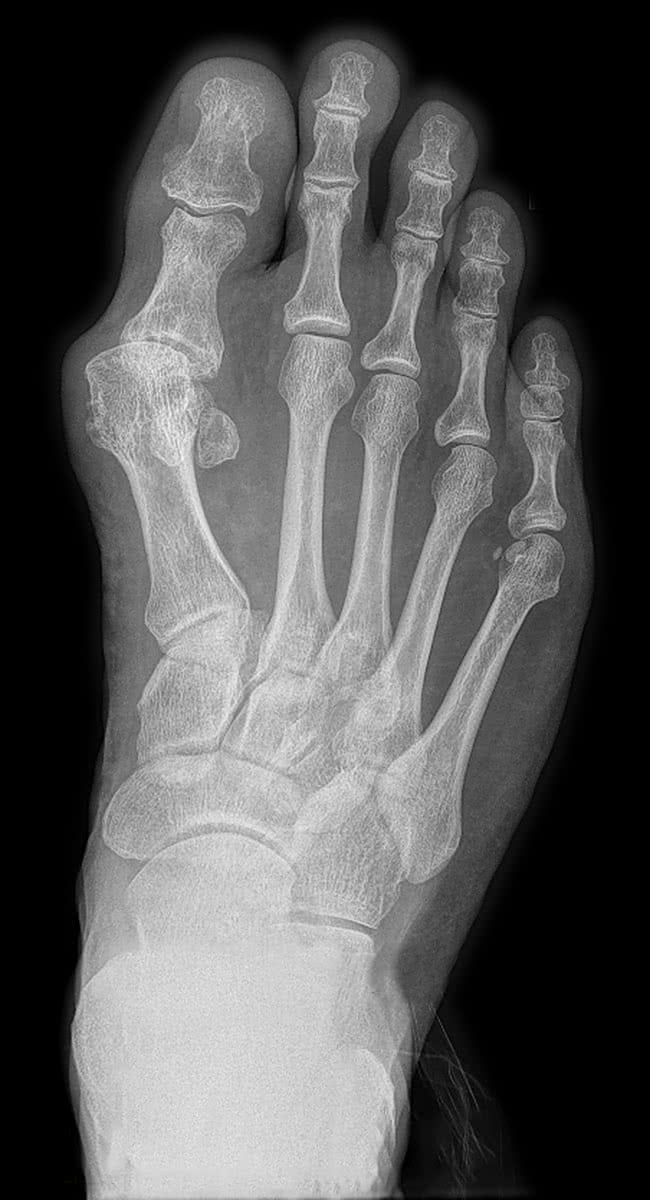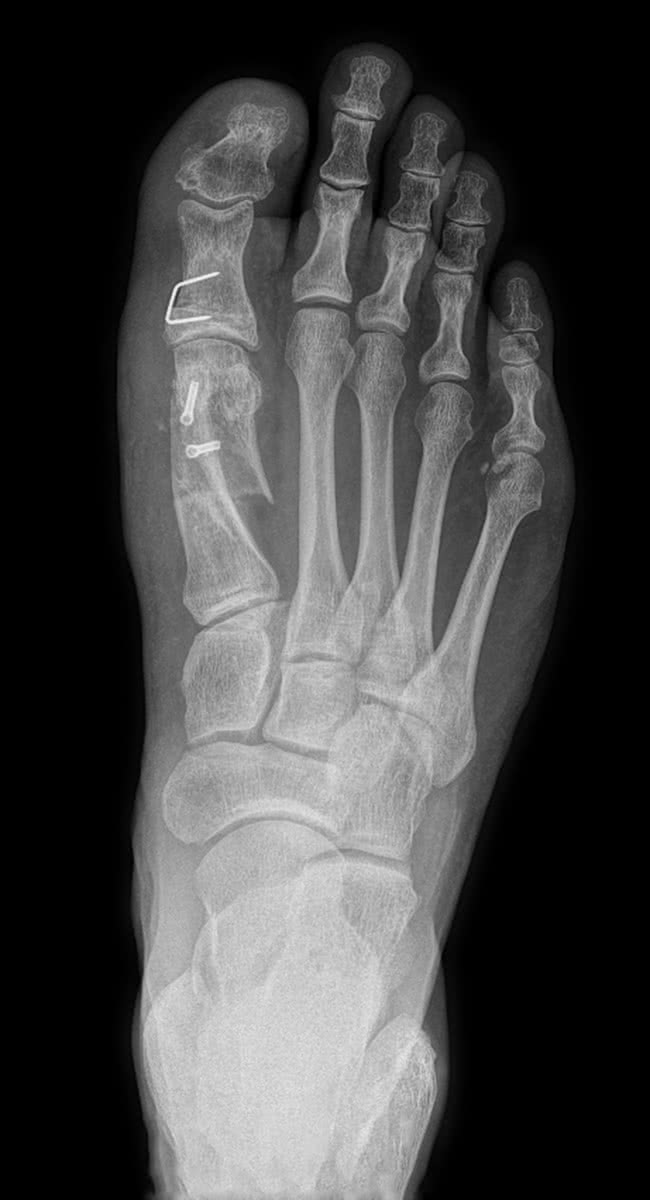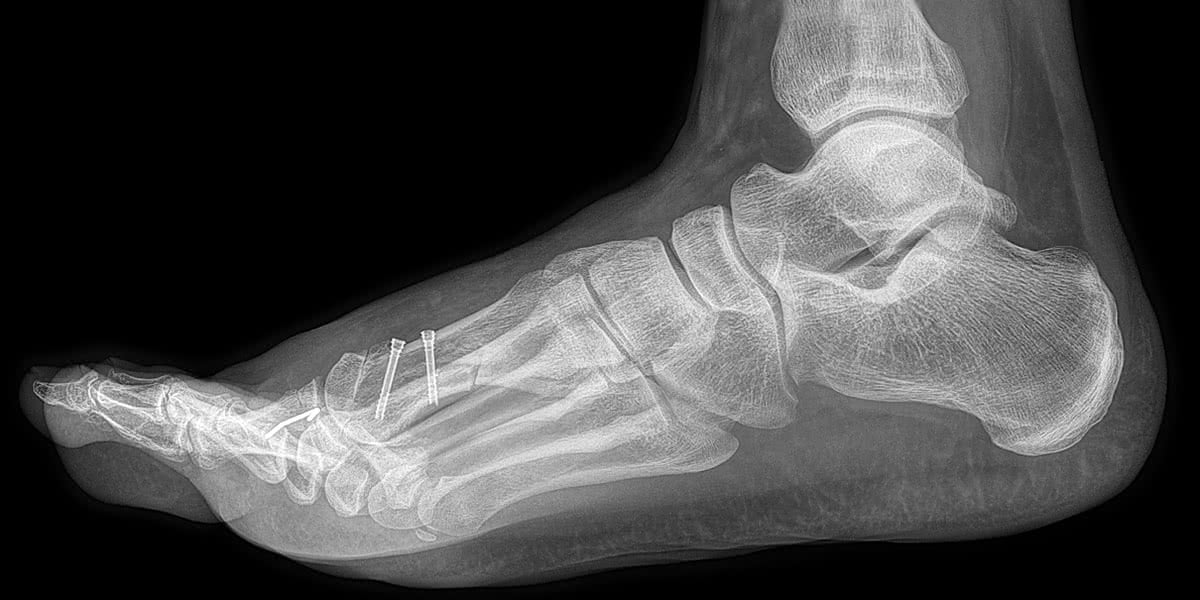Introduction
Hallux Valgus or Bunions are a common issue that causes many people in society significant discomfort and difficulty with footwear. The cause is not entirely understood, but is often inherited and/or related to flat foot / pronation deformity.
The Scarf / Akin osteotomy is one of many techniques available to correct the deformity.
Over recent years it has become the procedure of choice for most subspecialist foot and ankle surgeons in Australia due to its:
- Wide applicability for most patients.
- Versatility in correcting all components of the deformity and restoring the normal biomechanics of the toe.
- Stability of the osteotomy and hence less pain and swelling than some other operations, whilst allowing early weight bearing and bilateral simultaneous surgery.
- Avoidance of potential complications that occur with some other operations.
- Low risk of recurrent deformity.
Most patients are very satisfied with the outcome of surgery and are able to wear normal shoes, walk distances and participate in sport or other activities after surgery.
Indications
Surgical treatment of bunions is appropriate when the patient has tried all reasonable non-surgical treatments and has:
- Pain that stops them from participating in important activities in their life.
- An inability to find appropriate footwear.
- A rapidly progressive deformity, especially if it is affecting other parts of the foot.
Patients with diabetes, rheumatoid arthritis, or who smoke, are at a much higher risk of complications from surgery and may choose to avoid an operation at all.
Preoperative Instructions
You will be given a full briefing of how to prepare for your procedure well in advance of the day of surgery. In very general terms you will need to...
- Let our team know what other medication you are taking and follow our guidelines on taking these medications in the days / weeks before surgery.
- This is particularly pertinent to blood thinning medications such as aspirin, warfarin, clopidogrel and Xarelto.
- Let our team know if you develop symptoms of any illness (including a cold or fever) or if you believe you may be pregnant.
- If you smoke, stop smoking ideally several days or weeks ahead of the procedure, but at the very least not smoke after midnight the night before surgery.
- Maintain your strength and mobility as best as possible.
- Ensure the foot is clean, do not use moisturizer on the day of the surgery
- Not eat or drink anything for a minimum of 8 hours prior to admission.
- Bring all available and relevant imaging with you to hospital.
Procedure



After administration of a general anaesthetic and nerve block, an incision is made on the inner (medial) side of the foot. By working across to the other side of the toe joint the tendon and ligament that are pulling the toe sideways can be lengthened. The prominent bone in the bunion area is cut off, and the “scarf metatarsal osteotomy” is performed with a saw.
The term “scarf” describes the elongated Z shape of the cut and derives its name from a specialised woodworking joint. The “metatarsal” is the foot bone before the joint. It allows the separation of the far (distal) end of the metatarsal from the proximal end so that it can be moved across to narrow the foot and realign the toe straight. The scarf osteotomy is then pinned back together with screws.
The next part of the operation is known as the Akin osteotomy. This involves taking a thin wedge out of the bone beyond the joint (the phalynx). The wedge is closed and fixed with a staple. The ligament on the inner (medial) side of the joint are tightened and the incision closed with dissolving stitches under the skin. Dressings and bandages are applied.
Postoperative Instructions
After recovering from the anaesthetic, it is possible to mobilise short distances immediately after surgery. You will be fitted with a postoperative shoe over the bandages to allow this. It is best to stay in bed with the foot up as much as possible on the first night though.
It is extremely important to keep the foot elevated (above the level of the heart) as much as possible to reduce swelling. This is especially important over the first 2 weeks.
Most patients stay in hospital one night and will use strong pain-relieving medications for a few days only. The bandages are to be left in position until your review appointment. This will mean having to use plastic bags and tape to protect the dressings when showering.
At 10-14 days you will be seen and the wounds checked, and dressings are removed. You are welcome to try wearing shoes after this time. Initially you will only be able to wear very soft, loose shoes or sandals because of the swelling. Some people find runners or Ugg boots are best.
Move the toe through its full range of movement regularly over the next few weeks. Although it is possible to start returning to activity after this point, it is important to remember that the toe will still swell and ache if you do too much. Keep elevating it as required
At around 6 weeks after the surgery, an x-ray is undertaken to ensure the bones are knitting together well. The toe will remain swollen for at least another month, and it will usually take about 3 months from the date of surgery for full recovery.
It is usually about 4-6 weeks before patients can drive. You may gradually increase the amount of walking you do, but you must be guided by the ache and swelling in the foot. If its feeling tight and sore, rest and elevate the foot more and walk less.
Risks
All surgery carries with it some form of risk. Common risks that apply to all surgery, including hallux valgus correction, are...
- Bleeding.
- Formation of a blood clot (“DVT” or deep vein thrombosis) Pieces of clot in the leg can break off and lodge in the lungs causing a pulmonary embolism. This can be very serious, and in rare cases even cause death.
- Infection.
- Nerve damage.
- Difficulty getting the wound to heal.
- Abnormal pain reactions or nerve hypersensitisation known as complex regional pain syndrome (CRPS).
Risks specifically related to this procedure include...
- Fractures of the metatarsal bone, either during the operation, or whilst the osteotomy is healing.
- Stiffness or reduced range of movement in the toe joint.
- Pain (or even stress fractures) in other parts of the foot due the sudden change in biomechanics.
- Under or Overcorrection of the deformity.
- Recurrence of the deformity.
- Prominence of the screws, staple or edge of the osteotomy requiring removal or secondary shaving.
Related Information
Hallux Valgus (Bunions)
Bunions
Bunion Surgery
Ailments of the Big Toe – Bunions
